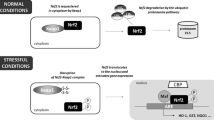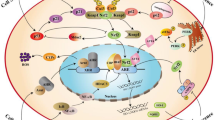Abstract
Mammalian myeloid cells are crucial effectors of host innate immune defense. Normal and pathological responses of these cells require adaptation to signaling stress through the hypoxia-inducible factor 1 (HIF-1) transcription complex. Adapted cells activate the mammalian target of rapamycin (mTOR), via S2448 phosphorylation, which induces de novo translation of vital signaling proteins. However, the molecular mechanisms underlying this signaling dogma remain unclear. Here, we demonstrate for the first time that inactivation of HIF-1, by silencing its inducible alpha subunit, significantly decreases mTOR S2448 phosphorylation caused by ligand-dependent activation of human myeloid leukemia cells. This shows that HIF-1 is essential for the activation of mTOR and serves at a crucial juncture of myeloid cell function in both in vitro and in vivo systems.








Similar content being viewed by others
References
Broudy VC (1997) Stem cell factor and hematopoiesis. Blood 90:1345–1364
Lee SJ, Yoon JH, Song KS (2007) Chrysin inhibited stem cell factor (SCF)/c-Kit complex-induced cell proliferation in human myeloid leukemia cells. Biochem Pharmacol 74:215–225
Welker P, Grabbe J, Henz BM (2004) Differential expression of mast cell characteristics in human myeloid cell lines. Exp Dermatol 13:535–542
Medzhitov R, Janeway C Jr (2000) Innate immunity. N Engl J Med 343:338–344
Akira S, Takeda K (2004) Toll-like receptor signalling. Nat Rev Immunol 4:499–511
Kagan JC, Medzhitov R (2006) Phosphoinositide-mediated adaptor recruitment controls Toll-like receptor signalling. Cell 125:943–955
Gibbs BF, Yasinska IM, Oniku AE, Sumbayev VV (2011) Effects of stem cell factor on hypoxia-inducible factor 1 alpha accumulation in human acute myeloid leukaemia and LAD2 mast cells. PLoS One 6:e22502
Lopez-Pelaez M, Soria-Castro I, Bosca L, Fernandez M, Alemany S (2011) Cot/tpl2 activity is required for TLR-induced activation of the Akt p70 S6k pathway in macrophages: implications for NO synthase 2 expression. Eur J Immunol 41:1733–1741
Dazert E, Hall MN (2011) mTOR signalling in disease. Curr Opin Cell Biol 23:744–755
Walmsley SR, Cadwallader KA, Chilvers ER (2005) The role of HIF-1alpha in myeloid cell inflammation. Trends Immunol 26:434–439
Krawczyk CM, Holowka T, Sun J, Blagih J, Amiel E, De Berardinis RJ, Cross JR, Jung E, Thompson CB, Jones RG, Pearce EJ (2010) Toll-like receptor-induced changes in glycolytic metabolism regulate dendritic cell activation. Blood 115:4742–4749
Dzeja P, Terzic A (2009) Adenylate kinase and AMP signalling networks: metabolic monitoring, signal communication and body energy sensing. Int J Mol Sci 10:1729–1772
Cheng SW, Fryer LG, Carling D, Shepherd PR (2004) Thr2446 is a novel mammalian target of rapamycin (mTOR) phosphorylation site regulated by nutrient status. J Biol Chem 279:15719–15722
Grimaldi C, Chiarini F, Tabellini G, Ricci F, Tazzari PL, Battistelli M, Falcieri E, Bortul R, Melchionda F, Iacobucci I (2012) AMP-dependent kinase/mammalian target of rapamycin complex 1 signalling in T cell acute lymphoblastic leukemia: therapeutic implications. Leukemia 26:91–100
Hanze J, Eul BG, Savai R, Krick S, Goyal P, Grimminger F, Seeger W, Rose F (2003) RNA interference for HIF-1alpha inhibits its downstream signalling and affects cellular proliferation. Biochem Biophys Res Commun 312:571–577
Yu EZ, Li YY, Liu XH, Kagan E, McCarron RM (2004) Antiapoptotic action of hypoxia-inducible factor-1alpha in human endothelial cells. Lab Investig 84:553–561
Olsson T, Gulliksson H, Palmeborn M, Bergstrom K, Thore A (1983) Leakage of adenylate kinase from stored blood cells. J Appl Biochem 5:437–445
Kennedy JF, Kay IM (1975) Effects of titanium compounds on a d-glucose-d-glucose oxidase assay system. Carbohydr Res 44:291–300
Georgescu P, Paunescu E (1960) Metode biochimie de diagnostic si cercetare. Medicala, pp 415
Nicholas SA, Bubnov VV, Yasinska IM, Sumbayev VV (2011) Involvement of xanthine oxidase and hypoxia-inducible factor 1 in Toll-like receptor 7/8-mediated activation of caspase 1 and interleukin-1beta. Cell Mol Life Sci 68:151–158
Sumbayev VV, Yasinska IM, Oniku AE, Streatfield CL, Gibbs BF (2012) Involvement of hypoxia-inducible factor-1 in the inflammatory responses of human LAD2 mast cells and basophils. PLoS One 7:e34259
Nicholas SA, Sumbayev VV (2009) The involvement of hypoxia-inducible factor 1 alpha in Toll-like receptor 7/8-mediated inflammatory response. Cell Res 19:973–983
Spirig R, Djafarzadeh S, Regueira T, Shaw SG, von Garnier C, Takala J, Jakob SM, Rieben R, Lepper PM (2010) Effects of TLR agonists on the hypoxia-regulated transcription factor HIF-1alpha and dendritic cell maturation under normoxic conditions. PLoS One 5:e0010983
Sumbayev VV, Nicholas SA (2010) Hypoxia-inducible factor 1 as one of the “signalling drivers” of Toll-like receptor-dependent and allergic inflammation. Arch Immunol Ther Exp (Warsz) 58:287–294
Gaidhu MP, Fediuc S, Anthony NM, So M, Mirpourian M, Perry RLS, Ceddia RB (2009) Prolonged AICAR-induced AMP-kinase activation promotes energy dissipation in white adipocytes: novel mechanisms integrating HSL and ATGL. J Lipid Res 50:704–715
Agani F, Jiang BH (2013) Oxygen-independent regulation of HIF-1: novel involvement of PI3K/AKT/mTOR pathway in cancer. Curr Cancer Drug Targets 13:245–251
Liu Z, Yuan Q, Zhang X, Xiong C, Xue P, Ruan J (2012) RY10-4, a novel anti-tumor compound, exhibited its anti-angiogenesis activity by down-regulation of the HIF-1alpha and inhibition phosphorylation of AKT and mTOR. Cancer Chemother Pharmacol 69:1633–1640
Finlay DK, Rosenzweig E, Sinclair LV, Feijoo-Carnero C, Hukelmann JL, Rolf J, Panteleyev AA, Okkenhaug K, Cantrell DA (2012) PDK1 regulation of mTOR and hypoxia-inducible factor 1 integrate metabolism and migration of CD8+ T cells. J Exp Med 209:2441–2453
Gwinn DM, Shackelford DB, Egan DF, Mihaylova MM, Mery M, Vasquez DS, Turk BE, Shaw RJ (2008) AMPK phosphorylation of Raptor mediates a metabolic checkpoint. Mol Cell 30:214–226
Author information
Authors and Affiliations
Corresponding author
Additional information
I. M. Yasinska and B. F. Gibbs contributed equally to this study.
Electronic supplementary material
Below is the link to the electronic supplementary material.
Rights and permissions
About this article
Cite this article
Yasinska, I.M., Gibbs, B.F., Lall, G.S. et al. The HIF-1 transcription complex is essential for translational control of myeloid hematopoietic cell function by maintaining mTOR phosphorylation. Cell. Mol. Life Sci. 71, 699–710 (2014). https://doi.org/10.1007/s00018-013-1421-2
Received:
Revised:
Accepted:
Published:
Issue Date:
DOI: https://doi.org/10.1007/s00018-013-1421-2




